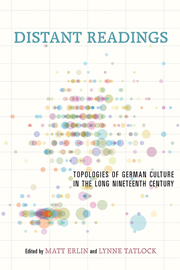Book contents
- Frontmatter
- Contents
- Acknowledgments
- Introduction: “Distant Reading” and the Historiography of Nineteenth-Century German Literature
- I Quantification
- II Circulation
- III Contextualization
- 10 The Vocations of the Novel: Distant-Reading Occupational Change in Nineteenth-Century German Literature
- 11 Big Data, Pattern Recognition, and Literary Studies: N-Gramming the Railway in Nineteenth-Century German Fiction
- 12 “Detoured Reading”: Understanding Literature through the Eyes of Its Contemporaries (A Case Study on Anti-Semitism in Gustav Freytag's Soll und Haben)
- 13 Can Computers Read?
- Selected Bibliography
- Contributors
- Index
11 - Big Data, Pattern Recognition, and Literary Studies: N-Gramming the Railway in Nineteenth-Century German Fiction
from III - Contextualization
Published online by Cambridge University Press: 05 April 2014
- Frontmatter
- Contents
- Acknowledgments
- Introduction: “Distant Reading” and the Historiography of Nineteenth-Century German Literature
- I Quantification
- II Circulation
- III Contextualization
- 10 The Vocations of the Novel: Distant-Reading Occupational Change in Nineteenth-Century German Literature
- 11 Big Data, Pattern Recognition, and Literary Studies: N-Gramming the Railway in Nineteenth-Century German Fiction
- 12 “Detoured Reading”: Understanding Literature through the Eyes of Its Contemporaries (A Case Study on Anti-Semitism in Gustav Freytag's Soll und Haben)
- 13 Can Computers Read?
- Selected Bibliography
- Contributors
- Index
Summary
In a talk given at an National Endowment for the Humanities (NEH) Summer Institute (2011) on advanced topics in the digital humanities, philosopher of science Paul Humphreys suggested that as soon as machines could create knowledge, a point in time he traces back to the launch of ENIAC in 1946, the distinction between the humanities and other fields of academic endeavor was rendered tenuous at best and probably even eliminated. One can, of course, quibble with Humphrey's use of the word knowledge when it comes to the data produced by computers. One can even take issue with using ENIAC as a marker for the beginning of the computer age. But even if one argues successfully that Humphreys overstates his case, one must admit that somewhere in the middle of the twentieth century, whether it was in 1941 when Konrad Zuse developed the Z3, 1943 when Alan Turing developed Colossus, or 1946 when ENIAC entered the picture, the way we pursue knowledge and the nature of research drastically changed.
It is not an overstatement to claim that information technology (IT) is the first technology in human history that touches everything. Philosopher of science Steven Shaviro polemically points out that IT is to humans what nature was in a bygone era—that is, “the inescapable background against which we live our lives and from which we derive our references and meanings.” If we take Shaviro's suggestion seriously and accept his conflation of nature and machines and the derivation of reference and meaning with regard to machines, we can no longer content ourselves with a strictly outlined traditional understanding of the humanities.
- Type
- Chapter
- Information
- Distant ReadingsTopologies of German Culture in the Long Nineteenth Century, pp. 285 - 300Publisher: Boydell & BrewerPrint publication year: 2014

